Researchers are delving into the intricate world of colloidal molecules (CMs), a category of artificially created clusters that replicate the geometries of natural molecules while exhibiting dynamic characteristics similar to proteins. In a study published on March 21, 2025, by a team of scientists, groundbreaking findings emerge about the dynamic and asymmetric nature of these colloidal structures, which are proving instrumental in material sciences.
The study leverages real-time three-dimensional imaging and simulations to investigate micrometre-sized colloidal-emulsion models that boast tunable electrostatic interactions. This dual approach allows researchers to observe how CMs can maintain stability while displaying configurational fluctuations and structural diversity. According to the authors, “Dynamic colloidal molecules’ angular symmetry evolves continuously from a liquid-like configuration, contrasting with a sharp first-order transition.” This highlights a significant shift in understanding how these particles behave, setting the stage for more controlled material designs.
The innovative experiments were based on a colloidal-emulsion model system comprising negatively charged satellite PMMA colloidal particles, each measuring around 1.2 micrometres across, and central emulsion droplets that range between 0.8 and 1.6 micrometres in diameter. Researchers utilized salt concentrations of both 1 μM and 5 μM to fine-tune the electrostatic repulsion between these particles. By doing so, they were able to observe how these assemblies evolve dynamically and asymmetrically, crafting unique configurations that deviate from traditional symmetric notions.
Prior studies often succumbed to challenges when attempting to depict the physical behaviors of CMs due to their rapid internal movements in solvent environments. However, this research provides clarity: the asymmetry observed within the dynamic structures emerges as a universal characteristic, one that reinforces the need for precise control in material assembly tasks. As stated by the authors, “Our findings contribute to a clearer physical understanding of dynamic colloidal molecules and offer potential solutions to the complexities inherent in their formation process.” This knowledge could significantly advance the development of sophisticated materials with specific structural properties.
Perhaps the most captivating finding relates to the polymorphic nature of 5-CMs. Unlike previous models that portrayed a singular structural strategy, this new perspective presents a more complex landscape of behaviors for CMs, where their arrangements can favor either triangular bipyramids or pyramids depending on the adjustments made to ionic strength.
The implications of these findings extend beyond merely understanding fundamental properties of CMs. The researchers propose a kinetic model that allows for the introduction of a ramping protocol, where ionic strength is systematically altered during the assembly phase. This could facilitate a higher yield of desired structures within shorter timeframes. Such optimization strategies could represent a significant leap forward in the synthesis of materials that require precise hierarchical ordering.
As chemical engineers and material scientists alike turn their attention to colloidal particles, understanding these dynamic entities could pave the way for novel applications across various industries, including drug delivery, nanotechnology, and creating advanced composites. By learning to manipulate the ionic conditions and harnessing the intrinsic properties of CMs, researchers can engineer complex structures previously considered unattainable.
In essence, this research casts new light on the crafting of dynamic colloidal molecules, enhancing understanding that could lead to advancements in material assembly and self-organization processes. Through continued exploration and fine-tuning of these processes, the future of colloidal chemistry appears ripe with possibilities, inviting further experimentation to fully engage with these versatile particles.

